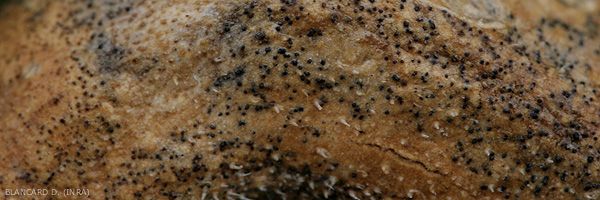
Macrophomina phaseolina
(Tassi) Goid., (1947)
- classification: Fungi, Ascomycota, Dothideomycetes, Incertae sedis, Botryosphaeriales, Botryosphaeriaceae
- Frequency and severity of disease incidence
Macrophomina phaseolina is wide spread in many countries around the world. It has a very wide host range and prefers hot and dry conditions. It colonises tobacco through the wounds that occur from suckercide applications.
- Frequency and severity of disease incidence
Macrophomina phaseolina is wide spread in many countries around the world. It has a very wide host range and prefers hot and dry conditions. It colonises tobacco through the wounds that occur from suckercide applications.
It has been observed in France on corn, sunflower, soybean, but never on tobacco.
- Symptoms
Macrophomina phaseolina produces black lesions on the basal portion of the stem that frequently extend to the vessels and pith. These lesions are dotted with numerous smooth, black, and hard microsclerotia. Sometimes, globose pycnidia may be formed, from which ovoid-ellipsoid, two-celled, red-brown conidia are released.
Macrophomina phaseolina produces black lesions on the basal portion of the stem that frequently extend to the vessels and pith. These lesions are dotted with numerous smooth, black, and hard microsclerotia. Sometimes, globose pycnidia may be formed, from which ovoid-ellipsoid, two-celled, red-brown conidia are released.
- Biology
This fungus does not appear to survive well as a saprophyte. Its survival is best ensured by microsclerotia formed on infected tissue. It grows easily during very hot and dry periods on plants weakened by these weather conditions.
- Protection Methods
A number of the methods recommended to control Thanatephorus cucumeris or Sclerotinia sclerotiorum, both in nursery and field, can also be used to control this disease. These include destruction of crop residues, soil disinfection, and crop rotation.
No fungicide is registered in France to control this disease.





